Depression is a slow atomic reaction that is spreading everywhere around us and consuming the peace of our minds. But why does this happens? As we start getting attached to anything, we start expecting from it something. Sometimes things happen within our expectations but sometimes they may disappoint you. Whether it is a person, pet, exams, health, future etc, attachment to anything or person can lead in depression. What happens in your mind because of this is a big turmoil that stresses the cranial/brain nerves and effect the entire Central nervous system, which is responsible to keep your senses, hormones in place. Yoga comes right here for the rescue! Whenever the CNS is affected with stress, our sympathetic nervous system becomes active. The sympathetic nervous system is responsible for creating defense mechanism against anything unfavorable. So when it is active your pupil becomes larger, your hearing capacity increases, perspiration goes up and heart beats shoots! This defense mechanism is good for some time, but prolonged duration of this can lead in stress and depression. Yoga helps in activating the parasympathetic nervous system that tells the brain that “All is well!”
Few points that one should keep in mind before doing the practice
Breathing is very important. Deep breathing is the answer to stress and good will power. Our natural tendency is to take multiple short breaths at the time of stress and that’s why the heartbeat increases. But if we go opposite to this, things change! Next time try to breathe deep after a stressful situation and see the difference. Actually our body’s oxygen supply lowers when we are depressed, at that time few rounds of deep breath can slow down the heartbeat faster. With every long breath we deliver the heart a large volume of oxygen, which ultimately reaches various parts of body making it active faster.
Accepting the tough time and increasing the will power
To accept the tough as a part of life is a very good positive suggestion one should follow at time of depression. Bad break up, back stabbing, unemployment etc happen to almost everyone and this doesn’t remain for a long time. Feeding your body with good food and workout can actually make so much difference. For example, people are afraid to hold the plank pose or do a tough asana for a long time. It becomes stressful to do that, but if you tell your brain that the toil of few more seconds can create a positive change in your life, then things change totally! Your body accepts the stress resulting in activation of parasympathetic nervous system and your will power to face it increases.
Love yourself
Always remember that the first person in your life is you and no one else. So respect yourself, trust your instincts and don’t depend on anyone else to surprise you. When feeling low, get out, treat yourself, eat your favorite food, watch your favorite movie and dress like a rock star! Love yourself and respect your decisions.
Follow the above two points in life with the following asanas and you won’t need a shoulder to lift you up when you are low.
ASANA 1: DHANURASANA/BOW POSE
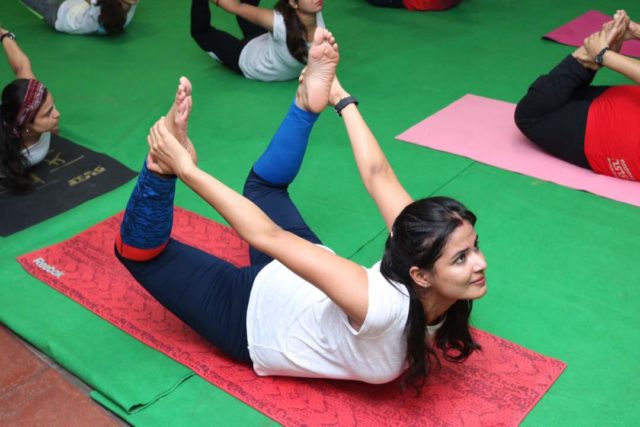
This asana stretches the nerves of the back to provide extra flow of blood and ease the movement of fluids in the spinal cord. Thus affecting the CNS and activating the parasympathetic nervous system.
- Lie down on your mat. Your stomach should face down
- Keep your hands near your thighs
- Bend your knees and try to hold your ankles or the big toes with your hand
- Now slowly lift the feet away from the buttocks.
- Inhale and lift your knee, thighs, shoulders and chin up. Keep on taking the feet away from the hips.
- Look up and stretch your chin
- Go up until your balance is completely on your naval. But don’t push yourself if your back has pain, slip disc, or any other ailment.
- Hold the asana for 10 seconds, two times.
ASANA 2: PRASARITA PADOTTANASAN
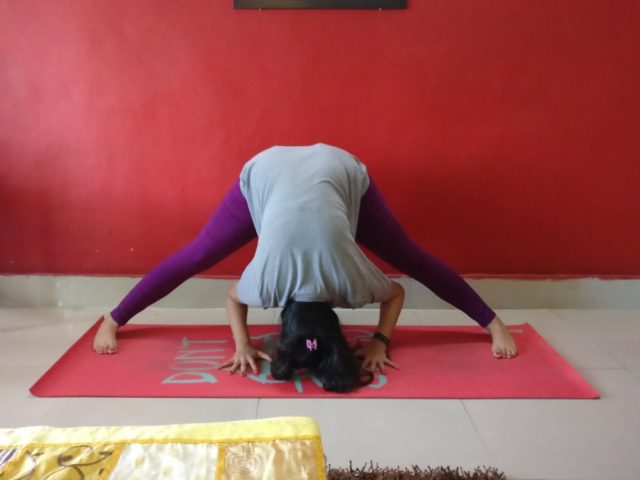
This asana helps in keeping the fatigue away and calms the tensed nerves in your body.
- Stand on your mat, with feet 3.5 to 4 feet apart.
- Inhale and take both the hands up and exhale deep to reach down with your hands
- Try to take both the hands down, between the legs.
- Try to open the legs wider with support of hands, remember to keep the knees straight
- Now squeeze your abdomen in, push your hips a little up and try to touch the head completely down on the mat. If you are beginner this may not happen right away, so stay half way, wherever you reach is fine!
- Stay in this asana for 10 seconds minimum
- Come back to normal position slowly. First take your head up and slowly take your heels and toes in and using the balance of hands stand straight.
ASANA 3: PASHCHIMOTTANASA ( SEATED FORWARD BEND)
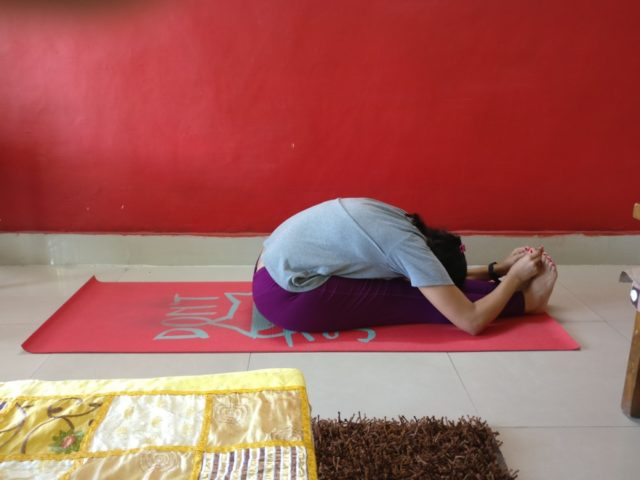
This asana energizes the whole body, give relief to anxiety and lowers down the anger.
- Sit on the backside of the mat with your feet forward
- Keep your back straight and hands near your hips
- Now align your legs. Keep the feet together, knee cap tight. Now get your toes in and heels out.
- Inhale and lift both the hands up stretching maximum up
- Now exhale deep, pulling the stomach in and reach forward with your head
- Remember try to keep the back straight in case of back pain don’t go too forward, stay halfway.
- Now hold the big toes/ankles/shin/knees, wherever you reach is fine
- Just check your knees and back to be straight.
- Exhale more to squeeze the stomach in and reach forward more.
- Staying longer helps, stay for minimum 10 seconds and do this for two times.
ASANA 4: SARVAANGASANA ( SHOULDER STAND )
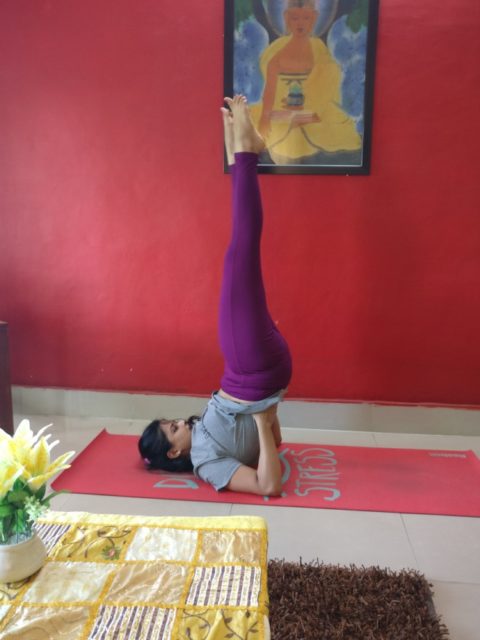
This asana brings balance in the endocrine system. It balances the emotions and nourishes the nervous system. It relieves anxiety and irritation.
- Lie down on your back
- Now Inhale and take both the legs up to 90 degrees. Feet should be together, toes should point up and legs should be straight.
- Bend your elbows and bring your hands closer to hips.
- Inhale again and lift the buttocks and lower back up, now place the hands on your hips and slowly slide your elbows in by joining the shoulder blades.
- Squeeze the stomach in and reach high up, now try to lift the middle back also up and slide the elbow stand of your hands further in and take your palms down to your lower back.
- Keep on reaching up this way and sliding the hands towards the back until your weight is on your shoulders or upper back.
- Hold the posture for at least 15 seconds
- Now bend the leg, slowly slide your hands down to your buttocks, bend the knee, and keep your back gently down and then your legs.
- Lie down in savasana for sometime after this asana and move your neck in case you incur any neck pain.
Note: People with high BP should avoid doing this for long.
ASANA 5: ADHO MUKH SVANASANA/DOWNWARD FACING DOG POSE
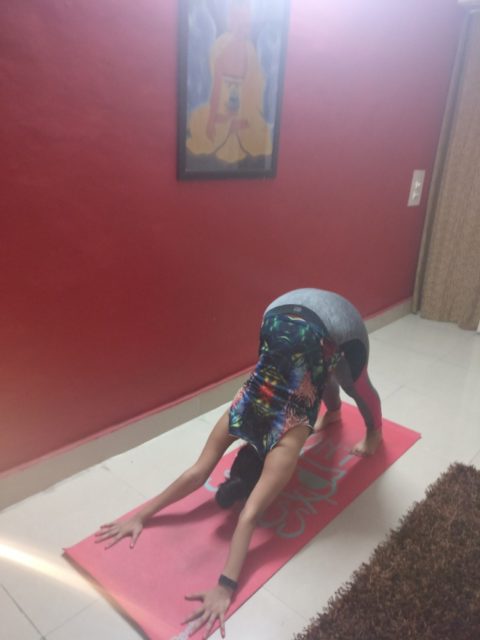
This asana helps in circulation of blood towards your head, thus relaxing the head and easing out the stressed nerves in the spine, neck and head.
- Come in the plank pose and now exhale and pull your stomach in and push your hips up, slowly bring your feet closer to the hands.
- Maintain a distance of 2-2/5 feet between hands and legs.
- Now slowly take your head deep down by sinking down with the shoulders.
- You have to make an upside down ‘V’ with your body, where the fulcrum of the V is your hips.
- Stay here for 15 seconds, close your eyes and keep your inhalation and exhalation deep.
ASANA 6: SHASHANK ASANA/ RABBIT POSE
Rabbit pose asana is a quick relaxation pose that can be done in the breaks between your yoga practices. It releases undue pressure from spinal muscles and calms the nerves.
- Sit at the backside of the mat with your feet forward.
- Bend your right knee and place it underneath your right hip and then bend the left knee and place it underneath your left.
- Keep the feet in a way so the big toes are together and heels are out.
- If you face problem sitting like that you can put a pillow underneath the hips to give relief.
- Now inhale take both the hands maximum up
- Exhale and push the chest head and stomach forward
- Rest your head on the mat forward and try not to lift the hip.
- Stay there with your eyes close and keep the breathing deep.
ASANA 7: SAVASANA/CORPSE POSE
This is the easiest of the poses but has immense benefits. Doing savasana with proper awareness of breath and body can relieve you from tension in no time. This asana is done with keeping the focus inside the body without any movements, so one can focus purely on breath. Doing so one can supply maximum oxygen to the heart and rest of the body and ease out the tensed nerves.
- Lie down on your back
- Keep your body loose, by releasing pressure from the neck, shoulders, back and rest of the body.
- Now keep your palms facing up near your thighs
- Lie down in a way so your hands are away from the body, fingers are separated, shoulders are down, neck is long, lower back is completely resting down and feet are away from each other.
- After checking so, close your eyes, keeping the facial muscles relax.
- Now don’t move for some time. The less you move the faster your body relaxes.
- Ignore the disturbances coming from outside world and focus within.
- With your eyes closed give positive suggestion to all the body parts from head to toe to relax.
- Focus on your breath and keep it slow and deep.























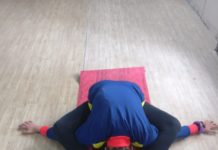


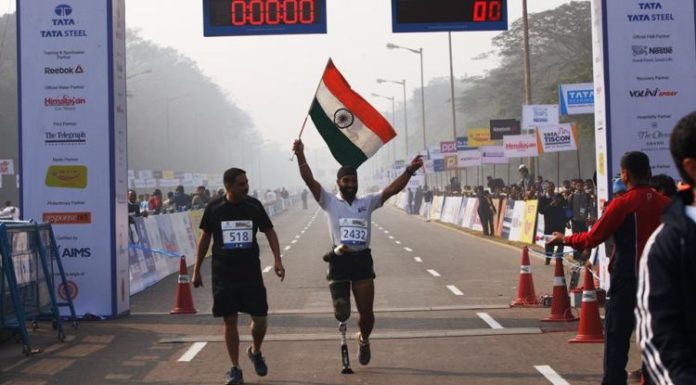





Nice one…
Can relate with “panch prana”..